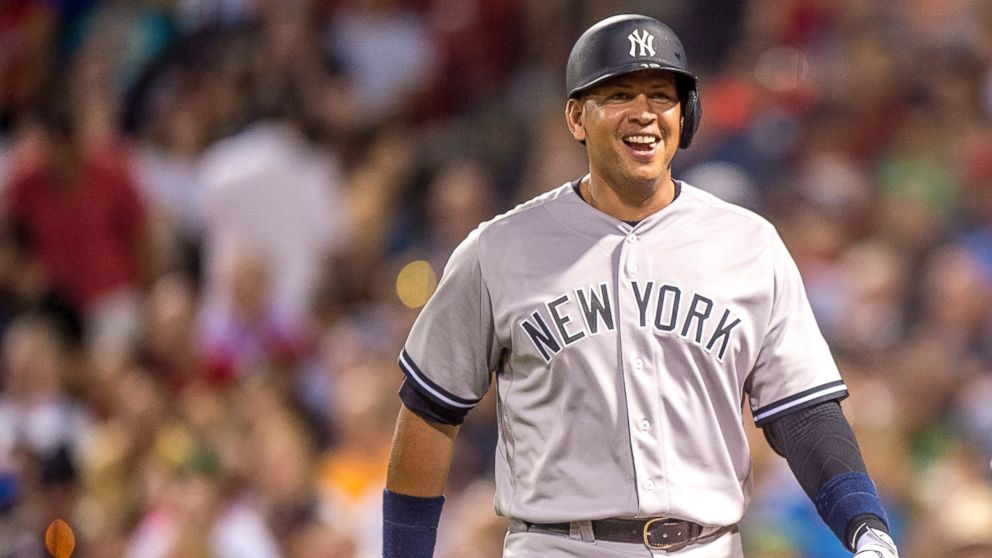Alex Rodriguez's Shadow Looms Large Over the Game
Rodriguez will become a special adviser to the Yankees.

— -- Bill James once wrote, “I’ve become convinced that every player who plays the game at the major league level for any length of time leaves an image lingering behind him, that if you really understood the history of baseball, that if one could see baseball, so to speak, with the eyes of God, one could see in each and every baseball game the image of every good and great player who has ever played.”
Alex Rodriguez’s shadow over the game looms large, as you would expect from a player of his stature. Sometimes that shadow is small. When you see a hitter with one of those big elbow pads, who do you see? A-Rod or Barry Bonds, right? I don’t know who the first player was to wear one, and other big stars such as Craig Biggio and Mo Vaughn may have first popularized the idea, but I’ll always think of Rodriguez diving into the pitch, protected by the big pad.
A-Rod’s name is all over the record books, of course. When you see that 2009 World Series pennant flying at Yankee Stadium, Rodriguez is part of that too. But his shadow has been cast in other ways as well.
The importance of service time.
When Rodriguez was 18, the Mariners called him up from the minors in 1994. He’d play 17 games, hit .204, and get sent back before the strike hit that season. Those 17 days would cost the Mariners. Rodriguez became eligible for free agency after the 2000 season, going a few days over the allotted six years of service time. Because they failed to properly monitor his big league time, the Mariners received just five full seasons from Rodriguez, plus parts of 1994 and 1995, when he hit .224 over 208 plate appearances.
So when you see the Cubs manipulating Kris Bryant’s service time -- for which they’ll end up getting nearly seven full seasons from him -- you’re seeing a lesson learned from Rodriguez and the Mariners.
The era of the mega-contract.
Rodriguez didn’t sign the first $100 million contract. That honor went to Kevin Brown, who had signed a seven-year, $105 million deal with the Dodgers after the 1998 season. Ken Griffey Jr. signed a $116.5 million extension with the Reds in February 2000, after they had acquired him from the Mariners. Then came the 2000-01 offseason. Mike Hampton would sign with the Rockies for $121 million. Manny Ramirez would sign for $160 million. But Rodriguez’s $252 million contract with the Rangers would stun the baseball world.
Rangers owner Tom Hicks was portrayed as a madman. Some viewed it as the death of baseball, or at least the impending death of small-market teams like the Pirates, Reds, Expos and Brewers. (OK, they weren’t wrong about the Expos.) “This amount of money spread out over 10 years could probably buy three franchises or so at the bottom end of market value,” lamented Sandy Alderson, then working in the commissioner’s office.
That the Rangers traded Rodriguez after three seasons didn’t change the megadeal philosophy. That A-Rod was traded was simply more proof that you aren’t even necessarily saddled with the entirety of a huge contract. Think of all the bad contracts that teams have been able to dump -- Vernon Wells, Matt Kemp (twice), Carl Crawford and so on.
Baseball revenues have continued to soar since 2001, as have the value of franchises. We’ve seen 66 long-term deals worth $100 million or more. The Pirates and Reds still exist.
A-Rod’s original deal with Texas remains the third-largest in total value, behind only Giancarlo Stanton’s extension with the Marlins and Rodriguez’s subsequent deal with the Yankees, but it certainly didn’t kill the sport.
The out clause.
Rodriguez’s deal with the Rangers included something rare at the time: The ability to opt out, in this case, after seven years. Rodriguez did exactly that after the 2007 season and inked that $275 million deal with the Yankees.
Out clauses have since become routine practice. Stanton has one. Clayton Kershaw has one. Jason Heyward got one with the Cubs that he probably won’t exercise. But A-Rod was the trend-setter.
Baseball’s last megastar.
Baseball has long yearned to be as hip with the cool kids of the NFL or NBA and bring in that younger demographic. But when A-Rod tried to go Hollywood, he ended up having Cameron Diaz feed him popcorn and instead became the butt of jokes.
You know what, though? A-Rod may be baseball’s last big star to transcend the sport on a pop culture level. He and Derek Jeter -- who dated his own string of starlets and models -- benefited not only from being great players, but also from playing in New York and appearing in the postseason with the Yankees year after year. Consider that Rodriguez’s Q-Score is 50 percent; the next-highest active player is Bryce Harper, way down at 20 percent. Like him or dislike him, Rodriguez always was interesting, unable to get out of his own attention-seeking ways, whether it was staring at himself in the mirror or holding forth with the media when he was benched in the 2012 playoffs.
Don’t use steroids.
Then again, A-Rod will end up making more than $400 million in his career. But at what cost? He got suspended for a year, he’s unlikely to make the Hall of Fame, his legacy will be forever tarnished. The story of steroids in baseball -- the story of A-Rod’s era -- can’t be told without him and a few others at the center of the discussion.




